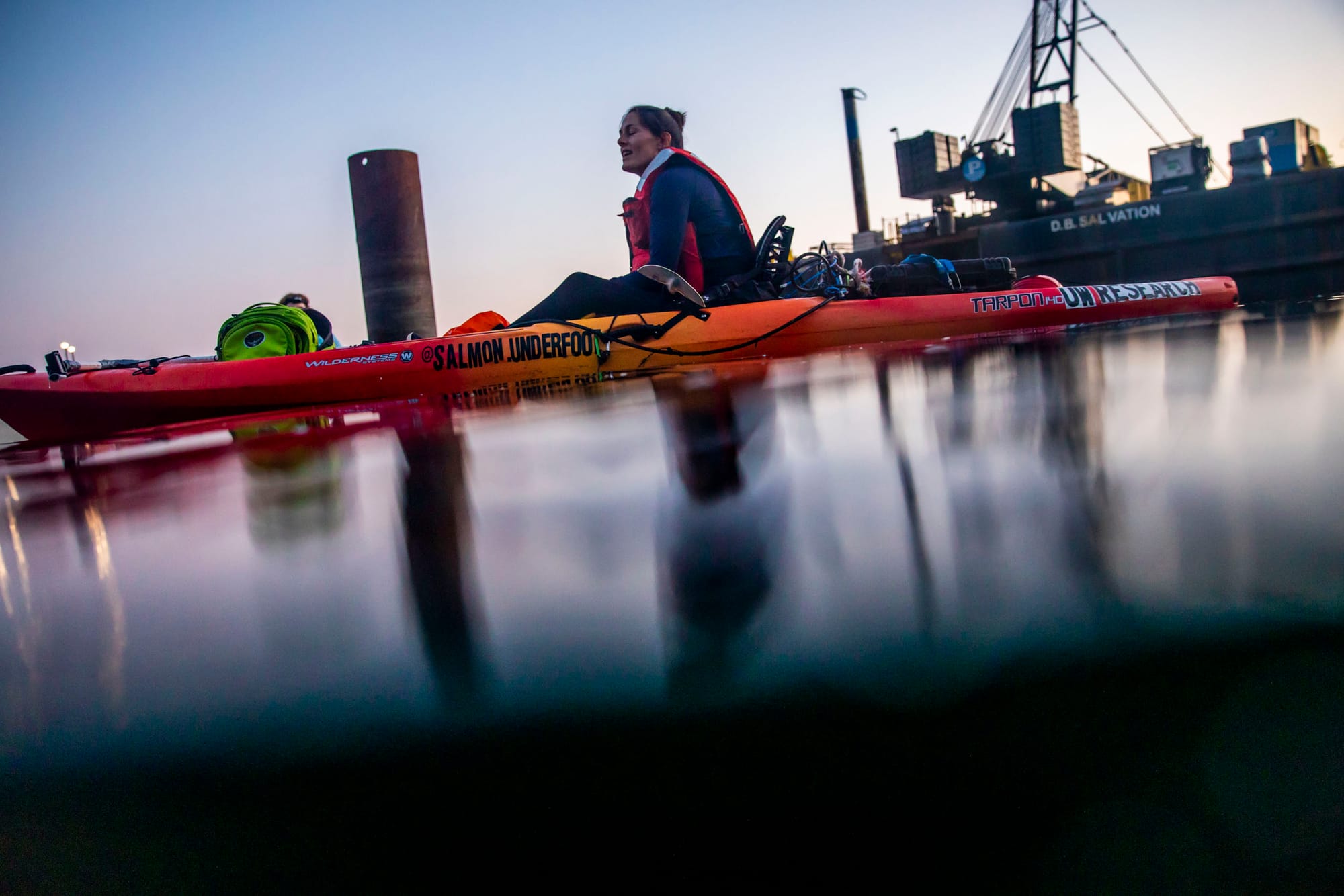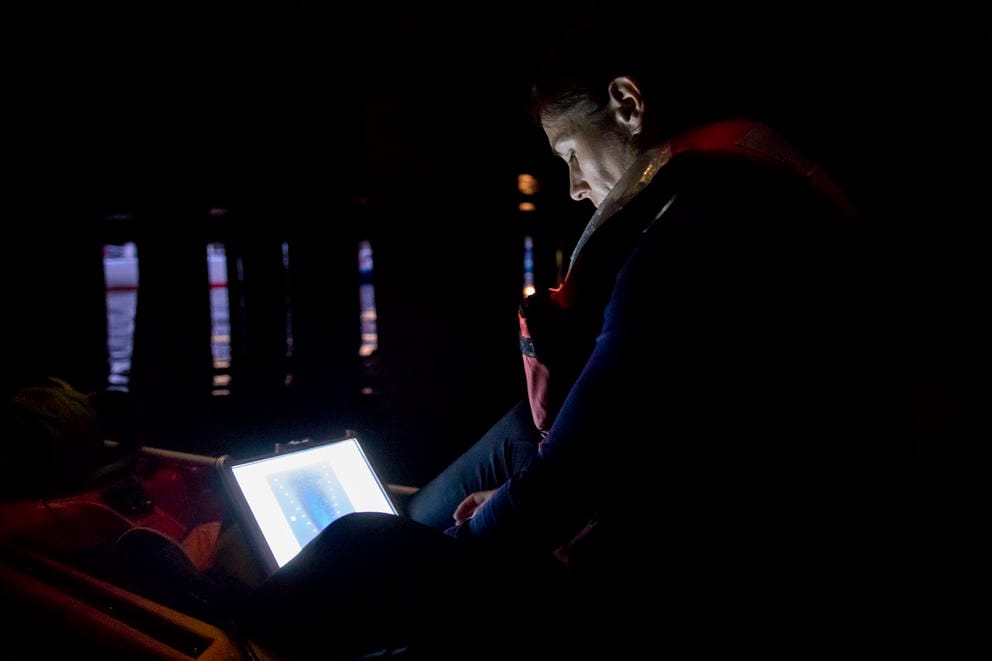Salmon researcher Kerry Accola is standing on the docks at Seattle’s Bell Harbor Marina on the edge of Elliott Bay.
“There's salmon right there. You can see them,” she says, gesturing toward a nearshore abyss. The setting sun reflects off the water’s surface, making it difficult to see anything more than bits of trash.
But Accola sees salmon. The Washington Sea Grant fellow knows what to look for after spending four months snorkeling this waterway with the University of Washington’s Seawall Project research group, in its effort to enhance and monitor salmon habitat along the newly renovated Elliott Bay Seawall.
Her colleagues are still snorkeling, but in recent months, Accola has been kayaking along the same section. At least once a week, about six hours at a time, at all times of day — sometimes with an intern, often alone — she paddles and collects data on how many salmon use the seawall corridor and the behavior they exhibit when they do. The way she’s doing this — with a hydroacoustic sonar camera mounted on the bottom of the kayak — is novel, and giving her access into a world few get to experience: the cultures of salmon, and Seattle’s harbor, at night.
“We know virtually nothing about [salmons’] nighttime behavior along the seawall,” says Jeff Cordell, a principal research scientist at UW who advises Accola.
Salmon depend on light for both navigation and feeding: Not understanding how these activities play out along the waterfront is a huge hole in our knowledge of how built environments impact the animals that lived there first.

What Accola is learning about these behaviors in response to the seawall could influence the management of seawalls in places that nearshore fish have been impacted by urbanization.
Accola developed a love of freshwater ecosystems in her native Wisconsin, and pursued a fishery biology career. When family brought her to Seattle a few years ago, she observed the new seawall construction and realized a latent curiosity in marine fish. She reached out to Cordell and began classes at UW’s School of Aquatic and Fishery Sciences (SAFS) program.
“I knew … that this was something exciting, a large-scale seawall modification project to benefit juvenile salmon,” she says. “I tried to think of ways to study them that would be able to give a complete picture of their migration behaviors along the waterfront.”
Accola first thought of tagging the fish, but the sheer number of salmon to tag would require significant effort and expense. There’s also the matter of “tag burden,” or tags that sometimes can irritate fish. She and Cordell settled on a hydroacoustic camera called the Dual-Frequency Identification Sonar 300m (DIDSON 300m). She spent last spring learning to use the technology, while snorkeling to get better at recognizing juvenile fish.
The 0.7-mile corridor is a critical juncture for juvenile salmon exiting their spawning grounds in the Superfund-designated Duwamish River and swimming toward the sea, where they spend most of their adult lives; but because of the structures that make up the Port of Seattle and the original seawall, built in 1936, Elliott Bay has effectively been boobytrapped.
“They school between the piers because the piers constrain them — they all jam up, waiting for low tide to go around, or go through all together,” Accola says. The new corridor is intended to expedite their journey.
Juvenile salmon are hardwired to stay close to shore in brightly lit water as they spend their adolescence fueling up on shallow-living invertebrates and getting big enough to head to sea. But the seawall, which stabilizes the ground beneath downtown Seattle and protects important underground utilities from briny saltwater, removed those shallow nearshore feeding grounds.
Seven species of salmon, including the federally endangered chinook (the orca food of choice), travel through that corridor. And while researchers don’t know how many fish use the corridor each year, or the extent to which the seawall impacted their survival rates, they do know it didn’t help: The salmon that did swim through rarely swam beneath the piers, and didn’t have great feeding opportunities along the seawall.
Between 2013 and 2017, as the southern section of the seawall was being replaced, Cordell’s team decorated the wall with salmon-friendly enhancements. These include things like textured walls to encourage vegetative growth that attracts shrimplike invertebrates; “marine mattresses” — deceptively named mesh bags filled with rocks — which artificially elevate the seafloor to house invertebrates closer to sunlight and make fish feel more comfortable feeding there; and light-penetrating glass sidewalks overhanging the corridor, to boost plant growth and help salmon navigate and hunt.
“[The idea is to create] better feeding opportunities, but also just a safer environment,” she says. “If [salmon] can stay close to nearshore in shallow water, where there are fewer predators, and don’t have to go around piers or wait for a really low tide [to continue], they can feed the whole way, instead of only feeding sporadically in between piers.”
The salmon enhancements made up only 2% of the overall seawall budget, but represent the largest-ever ecological engineering project in an urban marine setting. Researchers, including Accola, are contributing to a 10-year monitoring program studying the enhancements’ effectiveness in adjusting vegetation, invertebrate and salmon populations, while curious international engineers from as far as New Zealand follow along.

Kerry Accola tracks salmon with a hydro-acoustic camera under her kayak, June 14, 2019.
On a recent evening, Accola launched her kayak, southbound, at about 9 p.m., at low tide. Carrying a kit that includes two 25-pound deep-cycle batteries in a waterproof case, a laptop and lots of cables, she paddles alongside the new seawall, which is already beginning to speckle with green vegetation at lower elevations. Her plan: capture footage beneath three enhanced piers at two different depths; three unenhanced piers from the old seawall; and a few reference sites.
Accola won’t be out of the water until nearly 3 a.m., after which she’ll have to take her equipment back to the lab and hose it down. She sometimes listens to mystery podcasts during her shift, but generally feels that sound keeps her from being fully alert to water taxis, party boats, logs, waves and other hazards of waterfront navigation. She’s never seen another kayaker out here.
People like to talk to her from the sidewalk above when she’s paddling. It’s mostly positive and constrained to discussion of salmon health, “but very frequently I’ll have people say, ‘I'm gonna jump on your kayak,’” Accola says. She never lingers to test their claims.
A few times during the trip, she has to repeat sections. Ships create turbulence in the water, obscuring the ultrasound; so, too, do restaurant employees dumping buckets of water over the pier. She dodges jets of water shooting out below the aquarium, paddling in fluid lemniscates. Accola wasn’t a kayaker before this project, but she’s comfortable on the water and known to do 5-mile open-water swims.
For her data to have statistical significance, she has to collect it frequently. “If I go out one time and see all these fish somewhere, that doesn't really tell a story, right? That could have been random,” she says. “The more you go out and see it, the more power there is in your data.”
The time and effort is worth it, she says. Snorkeling — the predominant method for both — is limiting: Snorkelers can only cover so much ground at once, can’t go in the water during sewage overflows, can’t safely travel beneath the piers and have limited visibility at night and in dirty, or turbid, water.
Kayaking solves the distance and health safety issues, but the sonar camera — the DIDSON, developed by Bellevue company Sound Metrics — is the key to capturing the data in all conditions.
Accola could have used a waterproof video camera, but that’s prone to visibility limitations.
“Sonar is relatively unaffected by turbidity. I can see so much more than the snorkelers can, or a video camera, so I can go in the dark, I can go beneath piers, and I can go on really turbid days,” she says.
Similar to echolocation in animals, DIDSON emits 96 beams of high-frequency sound waves that bounce off solid objects, painting a picture of users’ surroundings and orienting them in space.
“It starts seeing in front of the kayak actually out to 8 meters, so fish startle but not before I have them captured on a recording,” she says.
Footage of Chum salmon during the day from the hydro-acoustic camera. (Video provided by Kerry Accola)
Sound Metrics co-founder Bill Hanot, an alumnus of UW’s Applied Physics Laboratory, says the tech was conceived for U.S. Navy harbor security systems to identify intruding divers, but was never deployed widely for that purpose. Instead, broad non-Navy interest pushed them to commercialize. “I can’t think of anyone using DIDSON for the exact application for which Kerry used our equipment,” Hanot says.
A UW facilities manager helped Accola weld a camera housing to hook to the kayak; Hanot and his colleagues trained her on the technology. Accola says it’s intuitive, but there was troubleshooting early on.
“Some of my first few days I called [Hanot] in a panic like, ‘I can't get it to work!’ And it was always a simple fix,” she says.
"It was total trial and error,” she says of putting the tech into practice. She knows of one group that has done academic research this way, at Rutgers, in a less high-stakes setting. “They looked at larger fish and they did do a camera mount, but the way they did it, we did not want to do.”
Footage of Chum salmon at night from the hydro-acoustic camera. (Video provided by Kerry Accola)
What she’s seeing — hundreds of fish, maybe a thousand, at a crack — makes the endeavor feel worth it. “We see juveniles migrating and feeding in the corridor, which is very positive! I also see more in the corridor at night, which could mean they are using the corridor [then] to migrate. They are definitely more dispersed at night,” she says. The team is seeing that the glass sidewalks don’t offer enough light to encourage the salmon to stay tight to the shoreline — they still push out into deeper water.
“The juvenile salmon are gradually migrating north, and we know some proportion goes out around the ends of the piers … during the day because they don’t like … the shade cast by the piers,” Cordell says.
Her project “really isn’t on anyone’s radar” because she hasn’t published yet, but the team is attempting to create public interest through social media. As an ambassador in the wild, Accola even has the team’s Instagram handle (@salmon.underfoot) printed on her kayak.
“It's kind of funny because our whole lab in our private life does not do social media, so we have to ask teenagers to help us,” she says.
She didn’t anticipate how much urban ecology would impact her research.
“It's not a pristine environment: There's a lot of fumes and pollution. Maybe I didn't consider all the navigation of barges, construction sites, mattresses in the water, things like that,” she says.
These difficulties make her reflect deeply on the salmons’ situation. “I mean, the salmon are here, right? This is the way they have to go. Millions of them.”

Correction: The spelling of Sound Metrics co-founder Bill Hanot's last name has been corrected.



